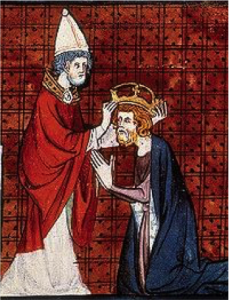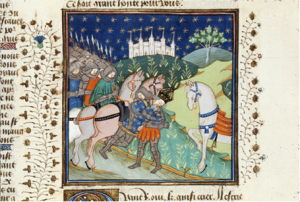On Christmas Day 800, Charlemagne, King of the Franks, was crowned emperor of a revived ‘Roman’ Empire. As such he ruled over a large part of Western Europe including what is now France, Germany, the Low Countries and northern Italy. His coronation by the Pope in Rome underlined both the symbolic continuity with the ancient Roman Empire and the strong relationship between Church and State. It is unlikely that Charlemagne expected his empire to last as the inheritance practice for the Franks was to divide land among male heirs, nor did he impose uniformity of customs over all his dominions; his empire was divided between his three surviving grandsons in 814. One could argue that the Carolingian Empire offered, and still offers, an early model for unity without uniformity: an expression of an understanding of a Western Europe that was united, yet, at the same time, wih many different cultures across its polities.

Charlemagne’s coronation from a fourteenth-century manuscript of Les grandes chroniques de France, British Library MS Royal 16 G VI, folio 141v.
In a recent article in History Today (April 2016), Professor Peter Wilson of All Souls College, Oxford, examined the Holy Roman Empire that was to emerge from Charlemagne’s imperium as the ‘First European Union’; For a timeline and introduction see http://www.historytoday.com/interactive/timeline-holy-roman-empire. But it is not only in this political and territorial authority over much of Europe that Charlemagne procided and continues to provide a model of European unity; the myths and legends of the great emperor became just as important in the medieval imagination as his actual historical power. By the twelfth century they had formed a kind of foundation myth for Europe, extolling the idea of a Western Christendom united against threats from the East and South (Spain). In these fictional narratives countries which had never been part of the Frankish Empire, including sometimes England and even Scotland, were often counted among the areas over which he had control. The narratives spread across virtually every literary cultures in Western Europe, from Scandinavia to the Mediterranean (as examined by the Leverhulme funded ‘Charlemagne: A European Icon’ project). Indeed, the survival of manuscript fragments testify to Charlemagne material being read in the Crusader States of the Eastern Mediterranean (perhaps having Israel compete in Eurovision has a precedent here!). In this respect Charlemagne became a kind of emperor for the whole of Western Christendom, and not just over the lands where the Franks indeed held immediate power.
The portrayal of Charlemagne himself in these works is not always constant. He is depicted sometimes as an almost ideal monarch, and at other times as one whose behaviour led to seemingly justifiable rebellions, as in the legend of the Four Sons of Aymon, or Renaud de Montauban. Such texts were politically engaged and had the potential to serve as warnings to monarchs as well as providing them with role models.

Renaud de Montauban takes Charlemagne prisoner. The image is from the prose version of the narrative found in British Library Royal 15 E VI, f. 182. The codex was a gift for Margaret of Anjou on her marriage to Henry VI in 1445.
As noted by Albrecht Classen in an essay for this web-site, the process of examining the myth of Charlemagne ‘might even be more important for our own concept of the past and our modern sense of historical identity than the actual facts in Charlemagne’s life’ (‘The Myth of Charlemagne from the Early Middle Ages to the Late Sixteenth Century’). Today Charlemagne continues to command a pan-European position, as witnessed by the Tour Charlemagne in Brussels and the Karlespreis, given annually by the city of Aachen to honour contributions to European unity, awarded in 2016 to Pope Francis.
This dissemination of the Charlemagne myth reveals the long-standing nature of the desire for some level of harmony and unity across Europe. As in the twentieth century, with the birth of the European Common Market, so in the twelfth, harmony was seen as preferable to war with one’s neighbours. It is true that different literary cultures stressed different aspects of these myths according to what was most relevant for their local political context of that nation, at a time, indeed, when a sense of independent nationhood was just developing. Even with this awakening sense of national identity, the ideal of unity transcended the particular, and at the centre stood the towering figure of Charlemagne.
Marianne Ailes (University of Bristol) 14 June 2016